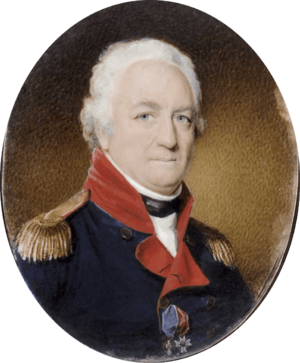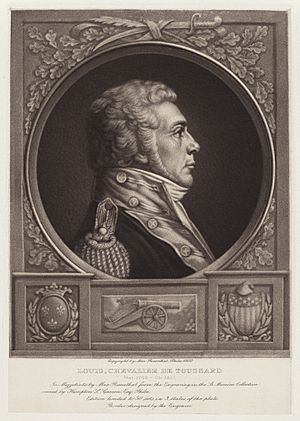Louis de Tousard facts for kids
Quick facts for kids
Louis de Tousard
|
|
|---|---|

portrait by Edward Greene Malbone
|
|
| Born | 12 March 1749 Paris |
| Died | 10 April 1817 (aged 68) Paris |
| Occupation | Military personnel, diplomat, engineer |
| Awards |
|
| Position held | Consul General of France in New Orleans |
Louis de Tousard (1749-1817) was a French artillery expert. He served in the American Continental Army during the American Revolutionary War. He fought alongside Marquis de Lafayette. Later, he received a special role in the US military.
Tousard wrote two very important books. One book suggested how to create a school for military officers. This idea became the plan for the West Point academy. His other book was a guide for artillery officers. It became a standard manual for the young American army.
Louis de Tousard's Life and Military Career
Louis de Tousard studied at the Strasbourg school of artillery in France. He joined the Continental Army between 1777 and 1778. During the Battle of Rhode Island, he was wounded and lost an arm. When he returned to France, he was honored with the Order of Saint Louis.
After facing some difficulties during the French Revolution in 1793, he came back to the US in 1795. He was given a role as a major in the 2nd U.S. Artillery Regiment. By 1800, he became a lieutenant colonel and the Inspector of Artillery. In this role, he oversaw the building of several forts along the US East Coast. He also supervised the creation and testing of cannons.
His ideas greatly influenced George Washington, the first US President. Tousard played a key part in setting up the U.S. Military Academy at West Point in 1802. This academy was first meant to train engineers and artillery experts. Its lessons were based on the famous French École Polytechnique. After leaving US service, he worked for France in military and diplomatic roles. In 1809, he published The American Artillerist's Companion. This book became the main guide for US artillery soldiers.
How Tousard Changed Gun Manufacturing
One of Tousard's biggest impacts was promoting the idea of interchangeable parts for guns. This idea came from Jean Baptiste Vaquette de Gribeauval. It meant that all parts of a gun would be made exactly the same. This way, if a part broke, it could be easily replaced with another identical part.
The War Department then set up armories (places where weapons are made). These were at Springfield and Harpers Ferry. Their goal was to perfect this idea of interchangeable parts.
Historians say that Tousard's book and his teaching were very important. They helped the US military adopt the idea of "system and uniformity" in making weapons. The War Department loved the idea of interchangeable parts. They pushed for it in their own armories and with private companies. Eventually, the War Department demanded that all weapon parts be interchangeable. This helped create what is known as the American system of manufacturing.
Other Military Projects
Major de Tousard also designed important forts. These include Fort Adams and Fort Hamilton in Newport, Rhode Island.


